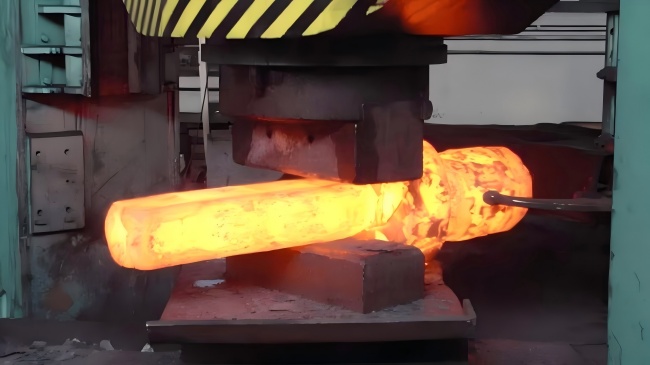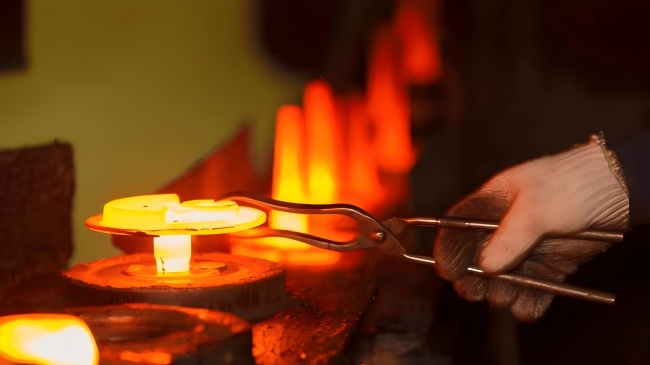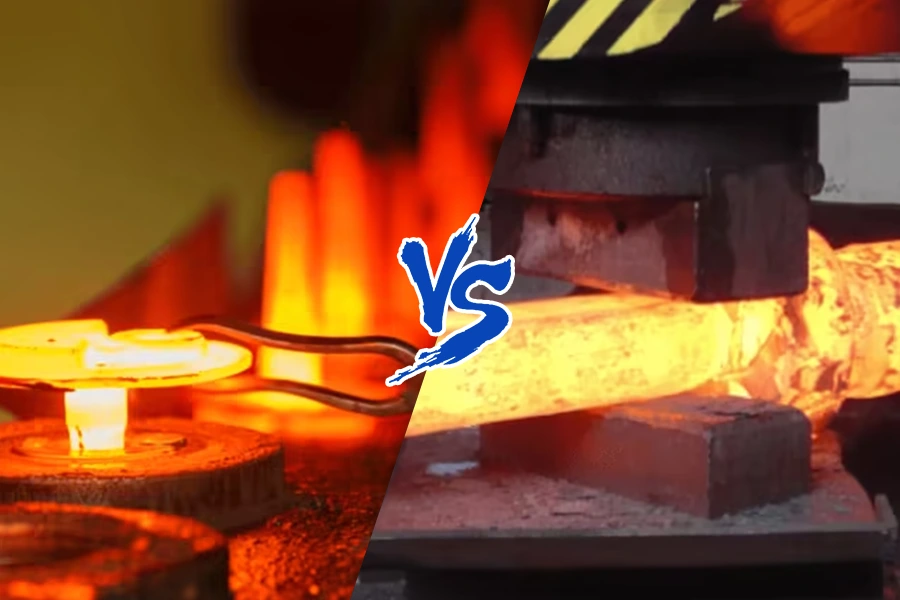In heavy manufacturing, forging is a key method that determines the strength, durability, and lifespan of important parts. As manufacturers aim for better efficiency, higher performance, and precise tolerances, choosing between open die and closed die forging becomes more important.
Understanding the differences between the various approaches is crucial because each has unique advantages, difficulties, and ideal applications.
Understanding the Forging Process
Forging is a time-honored manufacturing method involving the deformation of metal under intense compressive forces. From blacksmith hammering to contemporary hydraulic presses, it has a long history spanning thousands of years. Today, it remains indispensable for applications demanding superior mechanical properties and structural integrity.
Among the most common forging types are open-die forging and closed-die forging. While both transform raw billets into precise components, they diverge significantly in terms of scale, complexity, tooling, and cost-effectiveness.
What Is Open-Die Forging?

Open-die forging, often known as free forging or smith forging, consists of placing a heated metal billet between flat or mildly contoured dies that leave the workpiece partially exposed. The metal is gradually compressed and repositioned to achieve the desired shape, typically by repeated hammering or pressing.
This technique is particularly suited for large, simple-shaped parts and allows for excellent grain refinement, making it a go-to method for industries where size and strength are paramount.
Advantages of Open-Die Forging
- Superior Mechanical Properties: Continuous grain flow follows the contour of the part, enhancing fatigue resistance and structural strength.
- Flexibility in Sizes: Especially effective for massive or custom parts that exceed closed-die size limitations.
- Reduced Tooling Costs: Flat dies are relatively inexpensive to produce and maintain.
- Reduced Lead Times: It’s perfect for prototypes or small production runs because it requires less setup.
- Customizability: Allows on-the-fly adjustments during the forging process.
Limitations of Open-Die Forging
- Lower Dimensional Accuracy: Tolerances are broader due to manual repositioning and deformation control.
- Limited Shape Complexity: It can be challenging or impossible to create intricate features like voids or undercuts.
- Labor-Intensive: Skilled labor is required to monitor and manipulate the process.
- Material Waste: Compared to near-net-shape methods, trimming and machining may be more extensive.
Applications of Open-Die Forging
Industries that demand high-strength, oversized components rely on open-die forging:
- Aerospace: Turbine shafts, gear blanks, and landing gear parts.
- Energy Sector: Nuclear reactor vessels, generator rotors, and wind turbine hubs.
- Marine: Long propeller shafts and rudder stocks.
- Heavy Machinery: Hydraulic press columns, cranes, and construction cylinders.
What Is Closed-Die Forging?

Closed-die forging, also called impression-die forging, involves inserting a heated metal billet into a die that completely encloses the workpiece. Upon compression, the metal flows to fill the die cavity, conforming to intricate shapes. Flash (excess material) is often formed and later trimmed.
This method is ideal for high-volume, high-precision production of small to medium-sized components with tight dimensional tolerances.
Advantages of Closed-Die Forging
- High Dimensional Precision: Enables consistent, repeatable tolerances and excellent surface finish.
- Complex Shape Capability: Intricate designs, including thin walls, ribs, and bosses, can be forged.
- Efficient Material Utilization: Near-net-shape forging minimizes machining and waste.
- High Production Efficiency: Once dies are made, cycle times are rapid and production is scalable.
- Automation-Friendly: Suitable for robotic and CNC integration.
Limitations of Closed-Die Forging
- High Tooling Costs: Creating precision dies requires significant upfront investment.
- Size Limitations: Constrained by press tonnage and die dimensions.
- Longer Lead Times: Time is required to design, produce, and validate dies.
- Flash Removal Required: Additional processes like trimming and finishing are often necessary.
Applications of Closed-Die Forging
Closed-die forging is widely adopted in sectors requiring high precision and production volume:
- Automotive: Crankshafts, connecting rods, suspension parts.
- Agriculture: Transmission gears, tillage parts, axle spindles.
- Industrial Tools: Hammers, wrenches, and hydraulic fittings.
- Defense: Structural missile parts, gun components, and ordinance hardware.
Main Distinctions Between Open-Die and Closed-Die Forging
| Parameter | Open-Die Forging | Closed-Die Forging |
| Size Range | Large, custom-sized parts | Small to medium parts |
| Shape Complexity | Low to moderate | High |
| Dimensional Accuracy | Moderate (±0.5–2 mm) | High (±0.1–0.5 mm) |
| Surface Finish | Rough, post-machining required | Smooth, near-net-shape |
| Tooling Cost | Low | High |
| Setup Time | Short | Long (due to die creation) |
| Production Volume | Low to medium | High-volume batches |
| Labor Intensity | High (manual manipulation) | Low (automated setups possible) |
| Material Waste | Moderate | Low (with flash recovery) |
| Industries Served | Aerospace, Energy, Marine | Automotive, Tools, Defense |
Material Considerations in Forging
Both forging techniques accommodate a broad range of metals, and the material choice often influences the selected forging process:
- Carbon Steel: Economical and strong, used in both methods.
- Alloy Steel: Enhanced strength and toughness, ideal for high-load parts.
- Aluminum: Known for being light and resistant to corrosion, widely preferred in aerospace and automotive applications
- Titanium: Offers a superior strength-to-weight ratio, frequently chosen for aircraft structures and medical implants.
- Stainless Steel: Corrosion-resistant and durable, common in marine and food industries.
Cost Comparison
Cost-effectiveness is largely application-dependent. While open-die forging offers lower initial costs due to inexpensive tooling, it may incur higher labor and machining expenses. Closed-die forging, on the other hand, has substantial upfront tooling costs but becomes economically viable for high-volume production through lower per-part costs.
Manufacturers must evaluate:
- Expected volume
- Part complexity
- Design changes
- Material usage
- Secondary operations (e.g., trimming, machining)
Which One Is Better for Heavy Manufacturing?
There is no one-size-fits-all answer.
Use open-die forging when working with extremely large or custom parts requiring superior mechanical integrity and design flexibility.
Choose closed-die forging for mass production of intricate, consistent components with minimal post-processing.
The optimal method depends on your project’s size, complexity, and precision requirements.
Trends and Innovations in Forging Technology
Modern forging has seen remarkable innovation:
- Computer-Aided Die Design (CADD): Enables precise simulation of metal flow.
- Finite Element Analysis (FEA): Identifies potential defects and optimizes die geometry.
- Integrated Automation: Robotics streamline operations, especially in closed-die forging.
- Hybrid Forging Systems: Combine features of both methods for tailored performance.
- Real-Time Process Monitoring: IoT sensors track temperature, force, and material flow.
These tools minimize error, reduce scrap, and boost repeatability.
Environmental and Energy Considerations
Forging’s energy demands are significant, but sustainability is gaining ground through:
- Induction Heating: Lowers energy usage and helps decrease carbon emissions.
- Lubrication Advancements: Eco-friendly lubricants enhance die life and safety.
- Material Recovery: Flash and offcuts are recycled to lower waste.
- Digital Optimization: Real-time control minimizes unnecessary energy usage.
Closed-die forging typically yields less scrap, while open-die forging supports better recyclability of oversized billets.
Quality Assurance and Testing Methods
Regardless of forging type, stringent quality controls are vital. Common inspection techniques include:
Ultrasonic Testing (UT): Detects internal defects invisible to the eye.
Magnetic Particle Inspection (MPI): Surface-level flaw detection in ferromagnetic materials.
Hardness Testing: Confirms resistance to deformation.
Tensile and Impact Testing: Validates strength and toughness.
Dimensional Inspection: Verifies compliance with predetermined tolerances.
Quality certifications that guarantee worldwide competitiveness include ISO 9001, AS9100, and IATF 16949.
Industry Use Case Comparison
Case Study 1: Wind Turbine Main Shaft
A global renewable energy firm needed a 4-meter turbine shaft capable of withstanding extreme wind forces. Open-die forging was chosen to ensure fiber continuity along the shaft’s length. The result? A component with outstanding fatigue life and minimal post-processing requirements.
Case Study 2: Automotive Crankshaft Production
A leading auto manufacturer required over 100,000 crankshafts per year with exact tolerances. Closed-die forging offered the necessary precision and production speed. The process slashed costs by 20% and improved mechanical consistency across batches.
Final Thoughts: Which Forging Process Reigns Supreme?
Both open-die and closed-die forging play dominant roles in heavy manufacturing. Their strengths are complementary, not conflicting. When scale, geometry, and mechanical requirements align, each technique can be the ideal solution.
For low-volume, large-scale, high-strength components, open-die forging remains unmatched. For complex, precise, and mass-produced parts, closed-die forging is the industry benchmark.
